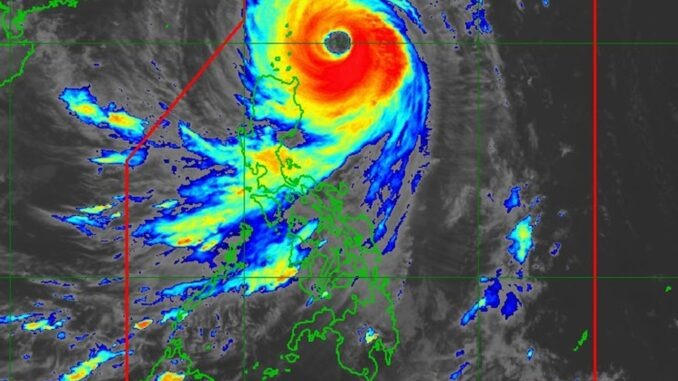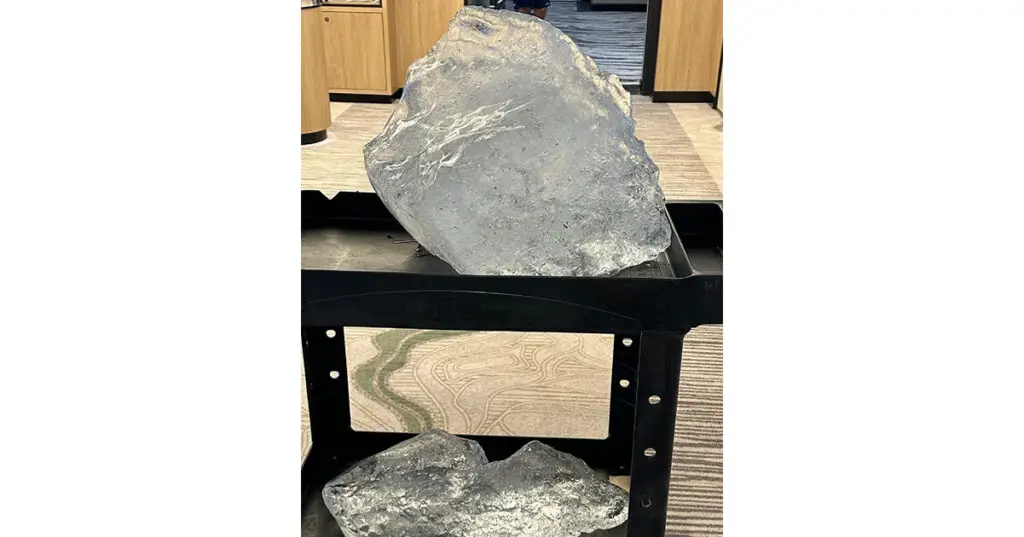
Ameteorologist has pointed out the sheer size of Typhoon Kong-rey’s eye as the massive storm approached Taiwan on Wednesday.
As of Wednesday afternoon, Typhoon Kong-rey had maximum sustained winds of 130 mph, according to the website Zoom Earth. The storm has weakened slightly since Tuesday night, when it was categorized as a super typhoon with maximum sustained winds of 150 mph, equivalent to a Category 4 hurricane. Forecasts anticipate that Typhoon Kong-rey will weaken further by the time it makes landfall in Kaohsiung in the early morning hours on Thursday.
On Tuesday night, meteorologist Noah Bergren of TV station WOFL in Orlando, Florida, commented on the size of the storm’s eye.
“Super Typhoon Kong-rey is easily one of the largest eye’s in a major tropical system you will ever see on Earth,” Bergren posted on X (formerly Twitter). “Thing is absolutely massive.”
A wave crashes outside of Fugang Harbor in Taitung, Taiwan, ahead of Typhoon Kong-rey on Wednesday. The storm is expected to make landfall in Taiwan early Thursday morning. Annabelle Chih/Getty
AccuWeather senior meteorologist Alan Reppert told Newsweek that having a large eye doesn’t necessarily imply anything about the storm’s strength.
“It just means the winds with it are farther away from the center than if it was a smaller eye,” he said. “It doesn’t necessarily have any major defining characteristic of the storm.”
Reppert added that a stronger storm that’s been around longer usually has a wider eye than a newer storm.
Most spaghetti models—or computer models illustrating potential storm paths—show Kong-rey making landfall on Taiwan’s southeast coast and cutting across the island before emerging with maximum sustained winds of around 75 mph. Models indicate that the typhoon will exhibit a northeastern turn away from China, which will take it out to the East China Sea.
Kong-rey’s strength is uncharacteristic for this time of year, The New York Times reported, adding that the typhoon is expected to make landfall equivalent to a Category 4 hurricane.
Reppert warned that strong winds up to 140 mph with higher gusts could hit southern Taiwan, though the storm is expected to weaken as it moves over the island. An AccuWeather report warned of “significant structural damage, mudslides and landslides” from the storm, as up to 3 feet of rain is expected to lash Taiwan. The storm could either maintain its intensity or strengthen before it makes landfall early Thursday.
Eastern China and Japan also are expecting heavy rain as the storm progresses.
A typhoon is classified as a severe tropical cyclone occurring in the Northwest Pacific. A hurricane is the term for the same type of storm in the Northeast Pacific and Northern Atlantic. Outside of these regions, the storms are called tropical cyclones.
82-year-old Martha Stewart is being attacked online after people spotted a detail in her new photo. I love Martha, but after seeing it, I’m not sure where I stand… Story in comments…

One of the names that springs to mind when we think of strong, accomplished women is Martha Stewart.
She is not only a well-known TV personality but also a writer, businesswoman, self-made billionaire, and former fashion model.
This amazing woman is 82 years old, but she still lives life to the fullest.
She garnered a lot of attention when she bravely posed in skimpy bikinis for the Sports Illustrated cover last year. She received recognition for her courage, amazing physique, and positive energy.
But when she recently shared some pictures from her vacation to Greenland’s east coast, one of them infuriated her supporters.
“End of the first zodiac cruise from @swanhelleniccruises into a very beautiful fjord on the east coast of Greenland,” the caption reads, beside a picture of Stewart sipping a cocktail. In fact, we managed to catch a tiny iceberg for our cocktails this evening.
Her use of the term “small iceberg” to describe her drink surely wasn’t intended to enrage her admirers, but it did make them angry.

People quickly began criticizing her article in the comments section, pointing out that she had mentioned a little iceberg at a time when the “ice caps are melting.”
One Instagram user said, “Martha, the ice caps are melting. Don’t put them in your drink.”
Another said, “I generally love Martha and the excesses of her life because he’s about beautiful gardens, homes, and food, but it’s a bit tone deaf for wealthy white people to be drinking their iceberg cocktails while the planet is burning.”
Thus, millionaires take vacations to the melting icebergs, scoop them up, and use them to keep their cocktails icy as the climate warms as a result of the riches of a few thousand people. That sentence has the feel of one from a dystopian book. Can’t make this stuff up, haha,” a third said.
“Even with global warming and ice caps disappearing, we still need glacier ice for cocktails? Discuss tone def. Been a lover for years, but lately, when I’m having trouble buying groceries, I’ve seen enough caviar that I’m out,” a fourth person commented.

Generally speaking, a lot of people adore Martha.
She claimed on the Today show, “I didn’t starve myself, but I didn’t eat any bread or pasta for a couple of months,” in reference to the Sports Illustrated cover she posed for.
“It was amazing that I went to Pilates every other day, and I’m still going because it’s that good. In any case, I lead a clean life that includes a nutritious diet, regular exercise, decent skincare, and other habits.
During her keynote address at the Las Vegas event, she also discussed the reaction of the audience to the “authentic” cover.
According to Stewart, “the response was really encouraging because it gave women of all ages the confidence to believe that they could succeed too.”
Please use Facebook to SHARE this post with your loved ones.



Leave a Reply